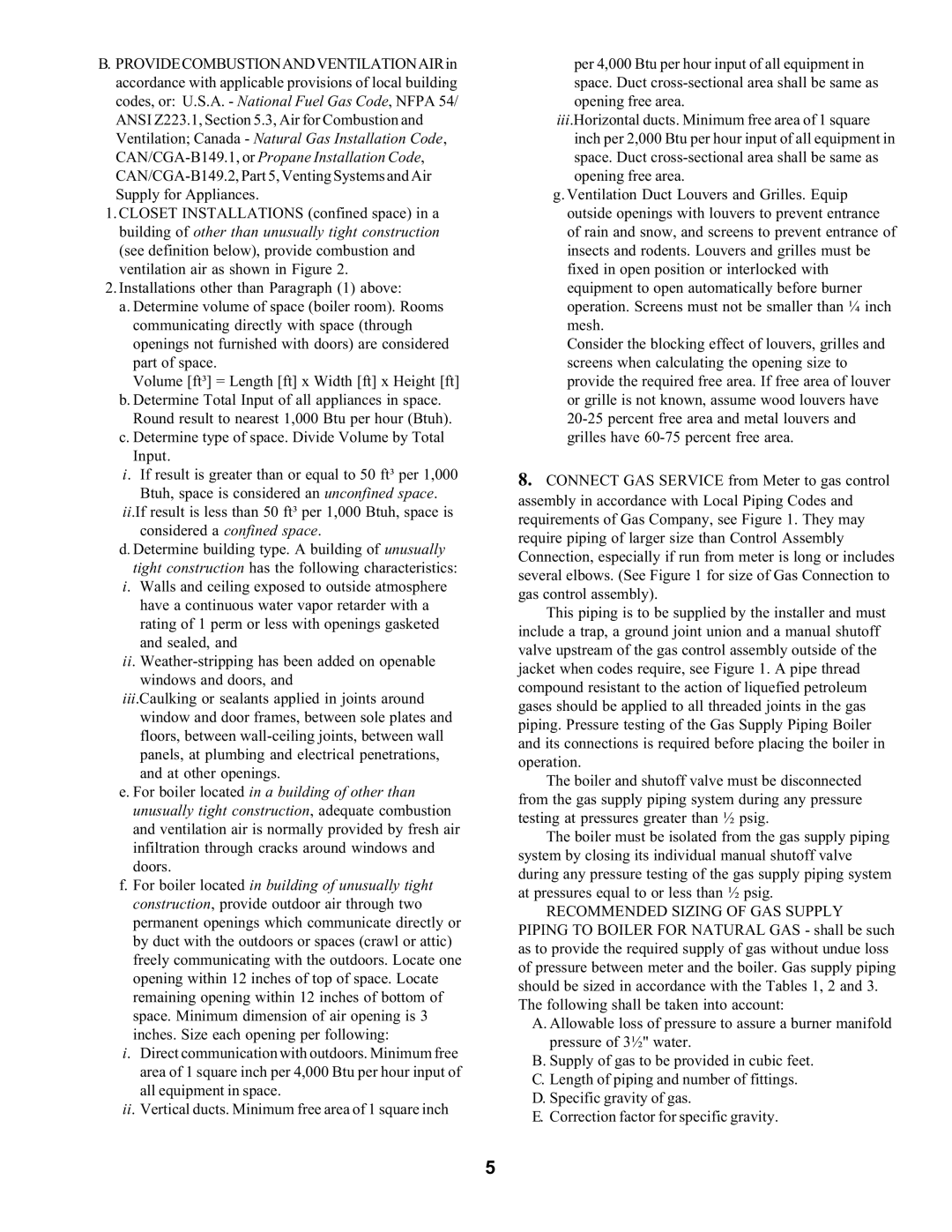B.PROVIDECOMBUSTIONANDVENTILATIONAIRin accordance with applicable provisions of local building codes, or: U.S.A. - National Fuel Gas Code, NFPA 54/ ANSI Z223.1, Section 5.3, Air for Combustion and Ventilation; Canada - Natural Gas Installation Code, CAN/CGA-B149.1, or Propane Installation Code, CAN/CGA-B149.2, Part 5, Venting Systems and Air Supply for Appliances.
1.CLOSET INSTALLATIONS (confined space) in a building of other than unusually tight construction (see definition below), provide combustion and ventilation air as shown in Figure 2.
2.Installations other than Paragraph (1) above:
a.Determine volume of space (boiler room). Rooms communicating directly with space (through openings not furnished with doors) are considered part of space.
Volume [ft³] = Length [ft] x Width [ft] x Height [ft]
b.Determine Total Input of all appliances in space. Round result to nearest 1,000 Btu per hour (Btuh).
c.Determine type of space. Divide Volume by Total Input.
i. If result is greater than or equal to 50 ft³ per 1,000 Btuh, space is considered an unconfined space.
ii.If result is less than 50 ft³ per 1,000 Btuh, space is considered a confined space.
d. Determine building type. A building of unusually tight construction has the following characteristics:
i. Walls and ceiling exposed to outside atmosphere
have a continuous water vapor retarder with a rating of 1 perm or less with openings gasketed and sealed, and
ii.Weather-stripping has been added on openable windows and doors, and
iii.Caulking or sealants applied in joints around window and door frames, between sole plates and floors, between wall-ceiling joints, between wall panels, at plumbing and electrical penetrations, and at other openings.
e. For boiler located in a building of other than unusually tight construction, adequate combustion and ventilation air is normally provided by fresh air infiltration through cracks around windows and doors.
f. For boiler located in building of unusually tight construction, provide outdoor air through two permanent openings which communicate directly or by duct with the outdoors or spaces (crawl or attic) freely communicating with the outdoors. Locate one opening within 12 inches of top of space. Locate remaining opening within 12 inches of bottom of space. Minimum dimension of air opening is 3 inches. Size each opening per following:
i. Direct communication with outdoors. Minimum free area of 1 square inch per 4,000 Btu per hour input of all equipment in space.
ii. Vertical ducts. Minimum free area of 1 square inch
per 4,000 Btu per hour input of all equipment in space. Duct cross-sectional area shall be same as opening free area.
iii.Horizontal ducts. Minimum free area of 1 square inch per 2,000 Btu per hour input of all equipment in space. Duct cross-sectional area shall be same as opening free area.
g. Ventilation Duct Louvers and Grilles. Equip outside openings with louvers to prevent entrance of rain and snow, and screens to prevent entrance of insects and rodents. Louvers and grilles must be fixed in open position or interlocked with equipment to open automatically before burner operation. Screens must not be smaller than ¼ inch mesh.
Consider the blocking effect of louvers, grilles and screens when calculating the opening size to provide the required free area. If free area of louver or grille is not known, assume wood louvers have 20-25 percent free area and metal louvers and grilles have 60-75 percent free area.
8.CONNECT GAS SERVICE from Meter to gas control assembly in accordance with Local Piping Codes and requirements of Gas Company, see Figure 1. They may require piping of larger size than Control Assembly Connection, especially if run from meter is long or includes several elbows. (See Figure 1 for size of Gas Connection to gas control assembly).
This piping is to be supplied by the installer and must include a trap, a ground joint union and a manual shutoff valve upstream of the gas control assembly outside of the jacket when codes require, see Figure 1. A pipe thread compound resistant to the action of liquefied petroleum gases should be applied to all threaded joints in the gas piping. Pressure testing of the Gas Supply Piping Boiler and its connections is required before placing the boiler in operation.
The boiler and shutoff valve must be disconnected from the gas supply piping system during any pressure testing at pressures greater than ½ psig.
The boiler must be isolated from the gas supply piping system by closing its individual manual shutoff valve during any pressure testing of the gas supply piping system at pressures equal to or less than ½ psig.
RECOMMENDED SIZING OF GAS SUPPLY PIPING TO BOILER FOR NATURAL GAS - shall be such as to provide the required supply of gas without undue loss of pressure between meter and the boiler. Gas supply piping should be sized in accordance with the Tables 1, 2 and 3. The following shall be taken into account:
A.Allowable loss of pressure to assure a burner manifold pressure of 3½" water.
B.Supply of gas to be provided in cubic feet.
C.Length of piping and number of fittings.
D.Specific gravity of gas.
E.Correction factor for specific gravity.
